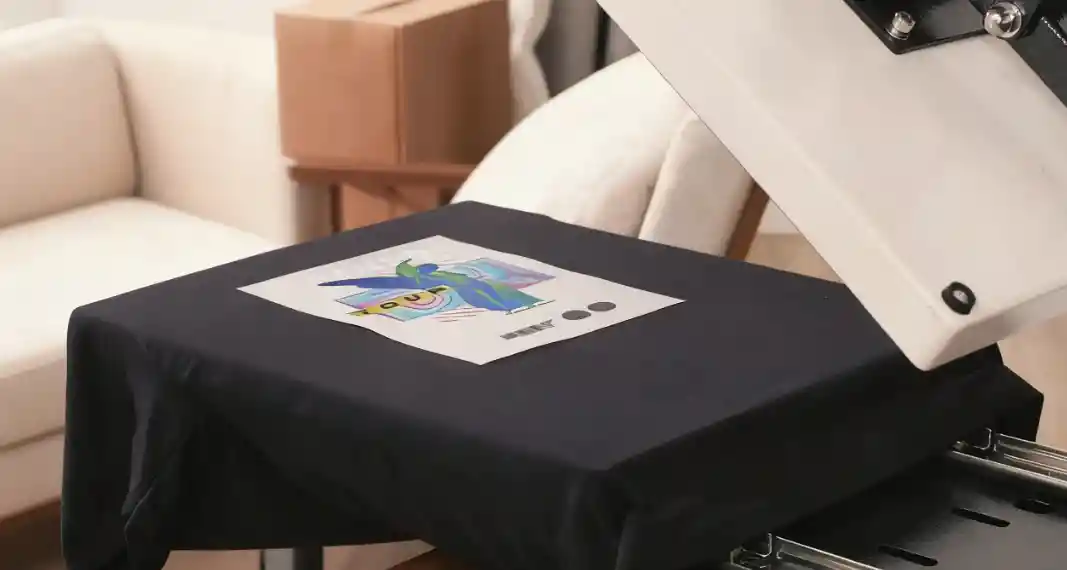
DTF printing has quickly become one of the most popular methods for creating vibrant, durable, and versatile designs on fabric.
Whether you're a small business owner or a hobbyist, understanding how to use DTF transfer film correctly is key to achieving professional-quality results.
In this step-by-step guide, we'll walk you through the entire process—from printing and powdering to pressing and peeling—so you can get smooth, long-lasting transfers every time.
What is DTF Transfer Film
DTF transfer film is a special type of printable film used to transfer designs onto fabrics.
Unlike traditional heat transfer paper, it works with Direct to Film (DTF) printing, which means your design is first printed onto the film, then coated with adhesive powder, and finally pressed onto the fabric.
When you use DTF film, you get prints that are:
- Bright and colorful
- Flexible and soft on the fabric
- Durable and long-lasting
You don't need fancy equipment to understand it, just the right printer, inks, and heat press. Think of it as a middle layer that carries your design safely until it sticks perfectly to the shirt or hoodie.
How Does DTF Printing Work
Understanding the Process
DTF printing, or Direct-to-Film printing, is all about creating a transfer design that can stick to fabric.
Unlike regular printing that goes directly onto shirts, DTF prints onto a special film first. This lets you capture every detail and color vividly.
You'll see why people love DTF for bright, complex designs—it's all about precision and clarity.
The Role of Ink and Powder
The printed ink isn't enough to stick to clothing by itself. That's why adhesive powder is added to the wet ink.
This powder melts during the heat process and bonds the design to the fabric. Think of it like glue that holds the ink in place. Without this step, the print would wash off easily.
Heat Makes It Permanent
Once the powder is applied, heat is applied to melt and cure it.
The combination of heat and pressure ensures that the design sticks firmly to the fabric. The process is quick but essential—this is what makes your design durable, soft, and long-lasting.

How to Use DTF Transfer Film: Step-by-Step
Step 1: Prepare Your Design
Start by making sure your design is exactly how you want it to appear. High resolution is important because DTF printing really shows every detail, so avoid blurry or low-quality images.
If there's any text, mirror it before printing; otherwise it will appear backward on the shirt. Bright colors work best because DTF makes them vivid.
Spending a bit of extra time refining your design now will save frustration later when the print doesn't match your expectations.
Step 2: Print Your Design on Film
Load your DTF film into the printer and make sure to use DTF inks only, as regular inks will not stick properly.
Print the design carefully and watch the colors as they come out, because small adjustments now are easier than fixing them after transfer.
Let the film sit briefly so the ink starts to set before adding powder. This pause helps prevent smudging and keeps the edges of your design crisp.

Step 3: Apply Adhesive Powder
Once the ink is still slightly wet, sprinkle the adhesive powder evenly across the design. Shake off any excess so only the printed areas are coated.
The powder is what makes the design stick during heat pressing, so don't skip this or rush it. If the coverage is uneven, your print might peel in certain areas.
Smooth, even powder coverage makes a big difference in the durability and feel of the final print.
Step 4: Heat Set the Powder
After applying powder, it's time to cure it. Use a heat press or oven according to the powder's instructions.
The heat melts the powder just enough to bond it to the ink without affecting the film. Be precise with temperature and timing; too hot can ruin the film, and too cold may leave the powder loose.
After this step, the film is ready to transfer, and the adhesive is fully activated, making sure your print sticks properly to the fabric.
Step 5: Transfer to Fabric
Place the film carefully on your fabric and use a heat press to transfer the design. Follow the recommended time and temperature for your material.
When you peel the film off, the design should be vibrant, smooth, and fully adhered. This method makes prints that feel soft to the touch and last through multiple washes.
Paying attention to positioning and pressure at this stage ensures the finished garment looks polished and professional.
How to Make DTF Prints Feel Softer
1. Understand Why DTF Prints Feel Stiff
DTF prints can feel stiff because of the way the ink layers sit on the fabric. Thick white underlayers and the main ink layer create a raised surface.
The hot melt powder and the coating on the film also add extra thickness. Compared with screen printing or DTG, DTF naturally feels heavier on your fingers.
Understanding this helps you know what to adjust if you want a softer result.
2. Design-Level Improvements
You can make a big difference just by changing your design:
- Reduce Underbase Opacity – Thinner white ink underlayers mean less stiffness.
- Use negative space and halftones – Leaving some areas of the fabric exposed or using halftones reduces overall ink thickness.
- Punch holes with RIP software – Some programs let you control where ink is applied digitally, creating a lighter feel.
These small changes in your artwork can make the print feel noticeably softer without changing your printing process.
3. Printing and Material Adjustments
Your choice of materials also matters:
- Choose a finer adhesive powder – It melts more evenly and creates a smoother surface.
- Experiment with different transfer films – Hot-peel and cold-peel films can feel different after pressing.
- Use quality ink – Premium inks tend to be thinner and smoother, which improves the final hand feel.
Trying different combinations can help you find the best balance between color intensity and softness.

4. Finishing Techniques
After printing, a few finishing tricks can soften the design further:
- Do a second press – Re-pressing slightly flattens the transfer layer.
- Use a textured press sheet (like pique fabric) – This adds a natural texture to the print.
- Adjust press temperature and pressure – Lowering or fine-tuning these can reduce stiffness.
These steps don't change the ink itself but improve how it feels against your skin.
5. What to Expect: Realistic Results
Even with all these adjustments, DTF has physical limits. You can get close to a lightweight screen printing feel, but it won't feel exactly like DTG or soft cotton printing.
Sometimes multiple tests are needed to find the right balance between color vibrancy and softness.
Being aware of these limits helps you manage expectations and make smarter tweaks.
Read More:
DTF Printer Daily Care Tips
Maintain Your Ink System
The ink system is the heart of your DTF printer, especially white ink, which tends to settle quickly. You should circulate or gently shake the white ink every day to prevent sediment.
For color inks, keep them flowing by shaking the bottles every few days and printing test color blocks. Don't forget a daily nozzle check to make sure your printhead is clear.
Before long breaks, flush the white ink lines with cleaning solution.
If you notice a thick layer or particles at the bottom of the white ink bottle, it means circulation is insufficient, and it's time to replace the ink.
Printhead Care
The printhead is the most critical and expensive part of your printer. Check the nozzles daily to make sure none are clogged or broken.
If you spot a missing line, perform a standard cleaning right away. If your printer will be idle for more than two days, inject cleaning solution to seal the head.
Also, maintain indoor humidity between 40%–60%, as dry or overly humid air can affect nozzle performance.
Cleaning System Components
Keep the mechanical parts clean to avoid ink build-up. Focus on:
- Scraper blade: clean ink residue every day.
- Cap top (absorption pad): clean every 2–3 days.
- The area around the printer base: keep it free of ink mist and dust.
A clean system prevents clogging and ensures consistent print quality.

Print on Demand Unisex Canvas Cross Back Apron with Pockets - Daily Accessories - PrintKK
Powder and Heating System
Daily maintenance of the powder and heating system is key. Clean the powder tray and conveyor belt to prevent clumping.
Regularly check the temperature settings and airflow to make sure they stay stable. Uneven heat or blocked vents can affect both transfer quality and powder consistency.
Rails, Carriage, and Belts
Mechanical movement should stay smooth. Add a small amount of lubricant to rails weekly.
Check belts for looseness or wear. In winter, consider using anti-static wires to reduce static buildup that can affect the print.
Electrical and Environment
Protect your printer from electrical issues by using a voltage stabilizer or UPS.
Keep the workspace clean, ventilated, and at a comfortable temperature between 20–30°C. Avoid direct sunlight and excessive dust near the printer.
Simple Maintenance Schedule for Beginners
Here's a quick reference:
Component | Frequency | Task |
White ink system | Daily | Circulate / shake / nozzle check |
Color ink system | Weekly | Light cleaning, print test blocks |
Scraper / cap top | Daily | Clean ink residue |
Powder system | Daily | Clean leftover powder |
Rails / belts | Weekly | Lubricate and check |
Full printer | Monthly | Check wiring, screws |
Long break | As needed | Seal printhead and white ink with cleaning solution |
Following these steps regularly keeps your DTF printer reliable and reduces downtime, helping you maintain consistent print quality.
Expert Tips
Now you know the steps for how to use DTF transfer film. By following each stage carefully, you can create clean, vibrant prints every time.
Remember to prepare your design, handle the film and powder correctly, and press with care. Daily printer maintenance also helps keep your machine working smoothly.
Using DTF transfer film can be simple and rewarding when you follow these guidelines.
FAQs
What are DTF transfers made of?
DTF transfers consist of a printed ink layer, a white ink underbase, a hot-melt adhesive powder, and a clear film. These layers work together to allow the design to stick to fabric when heat is applied.
Can you use DTF transfer film in a regular printer?
No, regular printers cannot handle DTF film properly. The process requires special DTF inks and print settings, which standard home or office printers cannot provide without modification or risk of damage.
Can you use a regular printer for DTF transfers?
Using a normal printer won't produce reliable results. DTF printing needs compatible inks, specific film types, and precise printing controls. Attempting it with ordinary inkjet printers can ruin the print and damage the machine.
How to prevent DTF transfer peeling?
To avoid peeling, ensure the fabric is clean, dry, and heat-resistant. Apply the correct temperature and pressure during pressing, and avoid stretching the area immediately. Proper curing and adhesive powder usage are essential.
Is DTF printing better than sublimation?
DTF printing works on many fabrics, including cotton, unlike sublimation which needs polyester. While it may feel slightly thicker, DTF provides bright colors and flexible application options across various materials.
How long does DTF printing last?
With proper care, DTF prints can last several years. Longevity depends on fabric quality, washing conditions, and heat applied during pressing. Following recommended maintenance keeps the design vibrant and intact.










 Global Shipping
Global Shipping





























